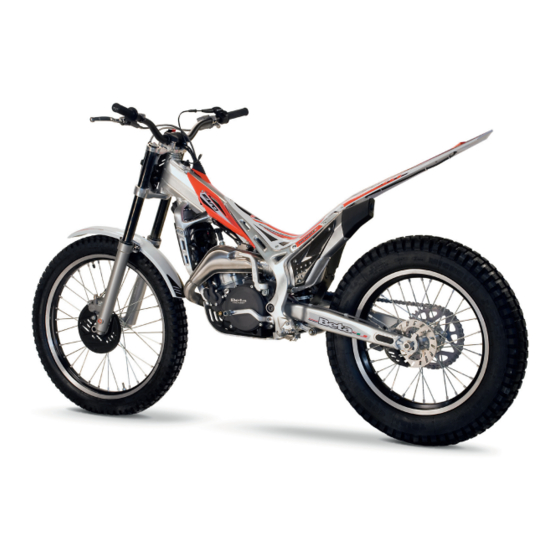
Summarization of Contents
Section 1: General Information
Main Parts Identification
Identifies the primary components of the motorcycle, such as the filter box and fuel tank.
Vehicle Identification Data
Details how to find frame and motor identification numbers stamped on the vehicle.
Instrument Panel and Controls
Explains the function of levers and grips on the handlebar, including clutch and brake.
Technical Data Specifications
Provides detailed specifications for cycle, suspension, brakes, and engine across different models.
Electrical System Diagram
Visual representation of the motorcycle's electrical system, showing component connections.
Section 2: Operation and Use
Pre and Post Ride Checks
Outlines essential checks for tires, spokes, nuts, chain, and air filter before and after riding.
Fueling Instructions
Provides instructions on fuel type, tank capacity, and recommended mixture.
Recommended Lubricants and Liquids
Lists recommended oils, greases, and coolants for optimal vehicle operation and longevity.
Engine Breaking-in Procedure
Guidance for the initial 10 hours of operation to properly break in engine components.
Engine Startup Procedure
Step-by-step instructions for starting the engine, including fuel valve and choke operation.
Map Switch Functionality
Explanation of selecting engine maps ('soft' or 'hard') for different terrain conditions.
Section 3: Maintenance and Checks
Gearbox Oil Check and Change
Procedures for checking the oil level and changing gearbox oil.
Brake Pump Oil Level
Instructions for checking and topping up front and rear brake fluid levels.
Clutch Pump Oil Level
Procedures for checking and topping up the clutch fluid level.
Fork Oil Replacement
Detailed steps for replacing fork oil in both the right and left shafts.
Air Filter Cleaning and Maintenance
Guide on accessing, cleaning, and maintaining the motorcycle's air filter.
Spark Plug Check and Replacement
Instructions on how to check electrode distance, insulation, and replace the spark plug.
Generator Resistance Check
Procedure for verifying generator resistance values using a multimeter.
Front Brake Pad Check and Replacement
Instructions for checking front brake pad wear and replacing them.
Rear Brake Pad Check and Replacement
Instructions for checking rear brake pad wear and replacing them.
Liquid Coolant Level Check
Procedure for checking the engine's liquid coolant level.
Silencer Inspection
Steps for checking the silencer and repacking fiber wool if needed.
Carburetor Cleaning and Adjustment
Guidance on periodically cleaning the carburetor and adjusting mixture at idling.
Valve Petals Inspection
How to check valve petals for signs of breakage or proper closure.
Rear Shock Absorber Leverage Maintenance
Maintenance procedures for the rear suspension linkage, including bolt tightening.
Checks After Cleaning
Post-cleaning checks for water ingress in the air box and gasket integrity.
Maintenance Schedule Overview
Summary of periodic maintenance tasks based on operating hours or kilometers.
Section 4: Adjustments
Brake Adjustments
Adjusting front brake lever position and rear brake pedal height.
Clutch Adjustment
Adjusting the clutch lever position and ensuring correct play.
Idling Speed Adjustment
How to correctly set the engine's idle RPM when the engine is hot.
Gas Clearance Adjustment
Adjusting accelerator cable play measured from the handle edge.
Carburetor Air Adjustment
Procedure for adjusting the carburetor's air screw, typically 1 1/2 turns from closed.
Steering Gear Check and Adjustment
Checking and removing play in the steering sleeve by adjusting related components.
Chain Tightening Procedure
How to adjust drive chain tension when play exceeds 20 mm and check wheel alignment.
Front Suspension Adjustment
Adjusting front fork spring preload based on rider weight for optimal suspension.
Rear Shock Absorber Adjustment
Adjusting rear shock compression settings for different suspension responses.
Section 5: What to Do in an Emergency
Troubleshooting Common Problems
Lists common problems like engine not starting or misfiring, with their causes and remedies.

















Need help?
Do you have a question about the EVO 2T 250 and is the answer not in the manual?
Questions and answers